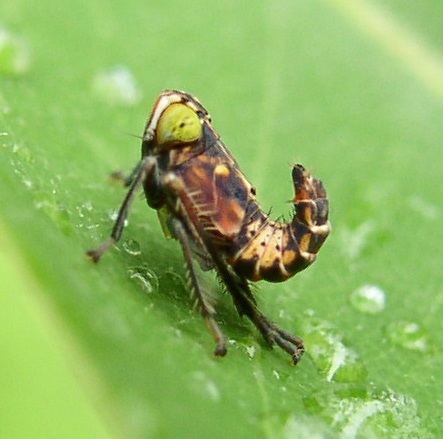|
Garumna
''Garumna''Melichar L (1914) Monographie der Tropiduchinen (Homoptera). ''Verhandlungen des Naturforschenden Vereines in Brünn.'' Brünn 53: 1-145. is a genus of Asian planthoppers in the family Tropiduchidae and tribe Tambiniini, erected by Leopold Melichar in 1914.FLOW ''Garumna'' Melichar, 1914 Species The following have been recorded from Thailand and westernMalesia
Malesia is a biogeographical region straddling the Equator and the boundaries of the Indomalayan and Australasian realms, and also a phytogeographical floristic region in the Paleotropical Kingdom. It has been given different definitions. ... : ...
[...More Info...] [...Related Items...] OR: [Wikipedia] [Google] [Baidu] |
Tambiniini
''Tambinia'' is a genus of planthoppers (Hemiptera) in the family Tropiduchidae and typical of the tribe Tambiniini (erected by Kirkaldy in 1907); species are found in Australia and Southeast Asia. Description These are small insects, body length less than 10 mm. Width of head rounded in front (through eyes) less than width of Pronotum. Forehead and mesonotum with three carinae and the ocelli are very small. The hind tibiae have three spines. Taxonomy In a 1982 revision (Fennah, 1982) ''Tambinia'' was included in the tribe Tambiniini, along with the genera: '' Athestia'', '' Biruga'', '' Garumna'', '' Garumnella'', '' Kallitambinia'', '' Kallitaxila'', '' Lanshu'', '' Neotaxilanoides'', '' Nesotaxila'', '' Ossoides'', '' Sumbana'' and '' Tauropola''. ''Tambinia'' is most similar to ''Nesotaxila'', ''Kallitaxila'' and ''Kallitambinia''Rong-rong Wang, Ai-Ping Liang (2011Taxonomic review of the genus Tambinia Stål (Hemiptera, Fulgoromorpha, Tropiduchidae) with descriptions ... [...More Info...] [...Related Items...] OR: [Wikipedia] [Google] [Baidu] |
Planthopper
A planthopper is any insect in the infraorder Fulgoromorpha, in the suborder Auchenorrhyncha, a group exceeding 12,500 described species worldwide. The name comes from their remarkable resemblance to leaves and other plants of their environment and that they often "hop" for quick transportation in a similar way to that of grasshoppers. However, planthoppers generally walk very slowly. Distributed worldwide, all members of this group are plant-feeders, though surprisingly few are considered pests. The infraorder contains only a single superfamily, Fulgoroidea. Fulgoroids are most reliably distinguished from the other Auchenorrhyncha by two features; the bifurcate ("Y"-shaped) anal vein in the forewing, and the thickened, three-segmented antennae, with a generally round or egg-shaped second segment (pedicel) that bears a fine filamentous arista. Overview Planthoppers are laterally flattened and hold their broad wings vertically, in a tent-like fashion, concealing the sides of ... [...More Info...] [...Related Items...] OR: [Wikipedia] [Google] [Baidu] |
Tropiduchidae
Tropiduchidae is a family of planthoppers in the order Hemiptera. There are at least 160 genera and 600 described species In biology, a species is the basic unit of Taxonomy (biology), classification and a taxonomic rank of an organism, as well as a unit of biodiversity. A species is often defined as the largest group of organisms in which any two individuals of ... in Tropiduchidae. See also * List of Tropiduchidae genera References Further reading * * Auchenorrhyncha families Fulgoromorpha {{Fulgoromorpha-stub ... [...More Info...] [...Related Items...] OR: [Wikipedia] [Google] [Baidu] |
Leopold Melichar
Leopold Melichar (5 December 1856 – 2 September 1924) was a Moravian entomologist and physician who specialized in the taxonomy of the leafhoppers. Melichar was born in Brno, Moravia and studied medicine in Prague before beginning practice in Vienna from 1888. He became an official in the ministry of health and in his spare time he took an interest in insects. Through the influence of Ladislav Duda he began to specialize in the leafhoppers, examining the collections of Uzel Uzel (; or Uzel-près-l'Oust) is a commune in the Côtes-d'Armor department in Brittany in northwestern France. It is about west-northwest of Rennes and north-northwest of Loudéac. The old school, in the centre of Uzel, was the scene of ... from Sri Lanka. Melichar returned to live in Brno in 1912 and during World War I he headed the local Red Cross Hospital. Melichar also collected in North Africa, Spain and around the Mediterranean and his collections were bequeathed to the Moravian Museum. Mo ... [...More Info...] [...Related Items...] OR: [Wikipedia] [Google] [Baidu] |
Malesia
Malesia is a biogeographical region straddling the Equator and the boundaries of the Indomalayan and Australasian realms, and also a phytogeographical floristic region in the Paleotropical Kingdom. It has been given different definitions. The World Geographical Scheme for Recording Plant Distributions split off Papuasia in its 2001 version. Floristic province Malesia was first identified as a floristic region that included the Malay Peninsula, the Malay Archipelago, New Guinea, and the Bismarck Archipelago, based on a shared tropical flora derived mostly from Asia but also with numerous elements of the Antarctic flora, including many species in the southern conifer families Podocarpaceae and Araucariaceae. The floristic region overlaps four distinct mammalian faunal regions. The first edition of the World Geographical Scheme for Recording Plant Distributions (WGSRPD) used this definition, but in the second edition of 2001, New Guinea and the Bismarck Archipelago we ... [...More Info...] [...Related Items...] OR: [Wikipedia] [Google] [Baidu] |
Auchenorrhyncha Genera
The Auchenorrhyncha suborder of the Hemiptera contains most of the familiar members of what was called the "Homoptera" – groups such as cicadas, leafhoppers, treehoppers, planthoppers, and spittlebugs. The aphids and scale insects are the other well-known "Homoptera", and they are in the suborder Sternorrhyncha. Distributed worldwide, all members of this group are plant-feeders, and many are vectors of viral and fungal diseases of plants. It is also common for Auchenorrhyncha species to produce either audible sounds or substrate vibrations as a form of communication. Such calls range from vibrations inaudible to humans, to the calls of many species of cicadas that can be heard for hundreds of metres, at least. In season, they produce the most characteristic and ubiquitous noise of the bush. Etymology The word auchenorrhyncha is from the Greek αὐχήν, 'neck, throat' and ῥύγχος, 'snout'. Classification Debate and uncertainty as to whether the Auchenorrhynch ... [...More Info...] [...Related Items...] OR: [Wikipedia] [Google] [Baidu] |
.jpg)

